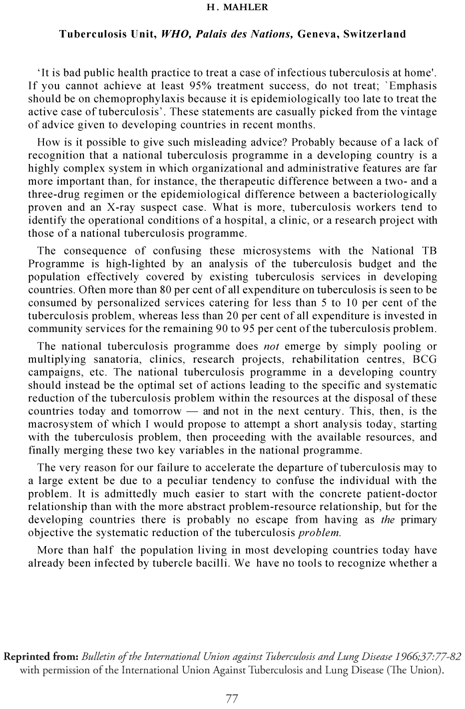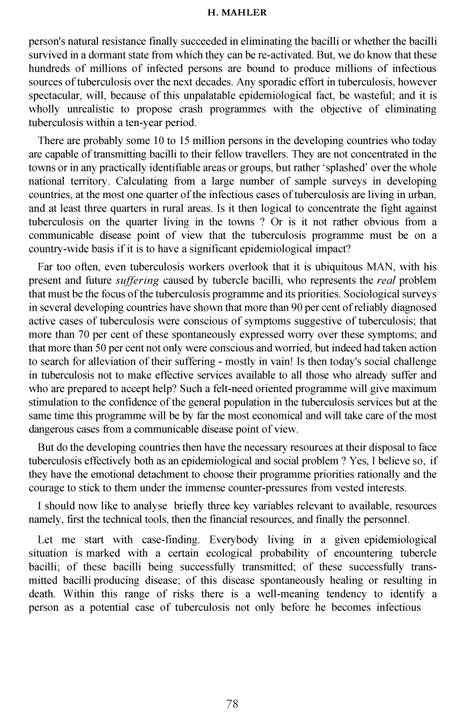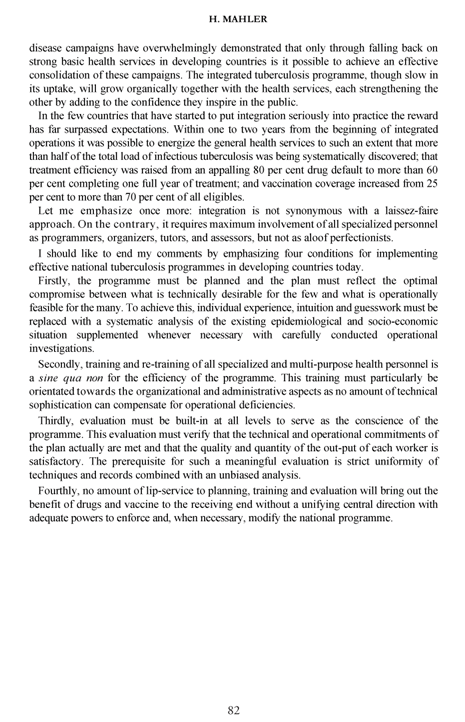PUBLIC HEALTH CLASSICS
The "verticalhorizontal" debates: time for the pendulum to rest (in peace)?
Mukund Uplekar1; Mario C Raviglione
Stop TB Department, World Health Organization, 20 avenue Appia, 1211 Geneva 27, Switzerland
"Historia magistra vitae" said Cicero: history is the teacher of life.1 It is an inevitable law of nature that unless there is a solid foundation of the past, no secure edifice of the future can be raised. Those who do not look at the past cannot devise means for the future; and unless the future is built on the past, it will be raised merely on stubble.2 The article on tuberculosis (TB) programmes in developing countries published in The Bulletin of the International Union against Tuberculosis and Lung Disease (1966; 37:77-82; reproduced here in full)3 four decades ago illustrates how past efforts to control TB could and should inform future interventions.
Dr Halfdan Mahler, WHO Director-General from 1973 to 1988, spent a decade in India beginning in the early 1960s and was instrumental in designing what became a blueprint for a national tuberculosis programme in a developing country. As WHOs Director-General he later promoted the concept of primary health care (PHC), eliciting extensive global support and initiating the healthfor-all movement. Like the swing of a pendulum, both PHC and global TB control efforts subsequently suffered a decline.4 The pendulum has, however begun to swing in the opposite direction. TB programmes have been reinforced and the PHC concept is being revived by WHOs new Director-General, Dr Margaret Chan (http://www.who.int/ dg/speeches/ 2007/eb120_opening/ en/index.html). The challenges facing national TB programmes today include TB/HIV co-infection, multidrug-resistant TB (MDR-TB), health sector reforms, effective community engagement and a need for new tools for diagnosis, treatment and prevention. These problems seem more complex, yet the fundamental approaches discussed in Mahlers article are still central to TB control and to addressing these current challenges. In addition to raising some pertinent questions, this commentary draws four key messages from the article that deserve the attention of all concerned: policy-makers, programme managers, scientists and activists.
Sporadic efforts to control TB are wasteful
A third of the worlds population is infected with TB, but the tools currently available cannot identify who will be responsible for producing millions of infectious cases of TB in the foreseeable future. The history of TB demonstrates that "Any sporadic effort in tuberculosis, however spectacular, will be wasteful; and it is wholly unrealistic to propose crash programmes with the objective of eliminating TB within a ten-year period". This is perhaps the most important message of Mahlers article. Notwithstanding some new tools that are emerging, this statement is as true today as it was four decades ago. TB control demands sustained and steadfast efforts on the part of everyone concerned.
Programme management is distinct from patient management
National TB programmes, as the article rightly suggests, ought to be a system with organizational and administrative features that allow pursuit of the optimal set of actions within the resources available to countries, currently and in the near future, leading to specific and systematic reduction of the TB problem. It draws attention to the tendency to confuse the individual TB patient with the public health problem of TB and of identifying the operational conditions for a hospital, clinic or research project with those of the programme.
The recent outbreak of extensively drug-resistant TB (XDR-TB) in a hospital in South Africa, and demonstration of its presence worldwide in diverse settings, raised an outcry and continues to receive media attention. Conversely, it is common to read accounts of spectacular demonstrations of managing TB in a small district or a project area by a voluntary or a research organization. Both failures and successes need to be viewed in the larger context, with an eye on scalability and appropriate lessons drawn to inform the national programme and to ensure that basic TB control is not derailed.
"The NTP does not emerge by simply pooling or multiplying sanatoria, clinics, research projects, rehabilitation centres, etc. there is no escape from having as the primary objective, the systematic reduction of the TB problem." This calls for a strong national programme sustained over a period of decades, taking into consideration "what is technically desirable for a few and what is operationally feasible for the many".
Understandably, the article repeatedly draws attention to developing countries limited resources and the need to match actions to these available resources. With public health receiving increasing attention and resources globally, the current situation is better. Also thanks to the "globalization of solidarity"5 and the pressure of activism, mechanisms such as the Global Fund to Fight AIDS, Tuberculosis and Malaria and UNITAID have been created. As a consequence, unprecedented funding is now available to poor countries to address specific public health problems of global concern. In this scenario, Dr Mahlers advice to countries would very likely be about sustainability, accountability and performance.
Integrate, not disintegrate
As they come straight from someone who was both a TB stalwart and a "father" of PHC, Dr Mahlers thoughts on strengthening general health services and integrating TB control are highly relevant to these current debates. Although it was penned years before the 1978 International Conference on Primary Health Care, in Alma-Ata, the article foreshadows the PHC concept that was to later occupy the centre stage in international public health. PHCs origins seemed to be rooted, as does its current revival, in "an acute shortage of medical personnel in developing countries for all major public health priorities including tuberculosis".
To address the then-prevailing human resource crisis, the paper suggests that "the staff of multi-purpose health centres can be trained in a few weeks in standard techniques of diagnosis, treatment, and immunization" and declares that "all communicable disease campaigns have overwhelmingly demonstrated that only through falling back on strong basic health services in developing countries is it possible to achieve an effective consolidation of these campaigns".
Does this mean that the national TB programmes should be fully integrated into general health services? While advocating that TB services indeed be thus integrated, Dr Mahler clarifies that integration, far from being a laissez-faire approach, requires "maximum involvement of all specialized personnel such as programmers, organizers, tutors and assessors".
Furthermore, he warns that "training (of multi-purpose workers) is of no avail yes, even potentially harmful, if the techniques are not employed within the supervisory framework of a programme having pre-determined efficiency forecasts and built-in control of actual achievements". He addresses the doubts related to integration in concluding that, " a TB programme first and foremost needs specialists in epidemiology, operational research, programming, training and evaluation". And finally, "no amount of lip-service to planning, training and evaluation will bring out the benefit to the receiving end without a unifying central direction with adequate powers to enforce and, when necessary, modify the national programme". It is unclear why, despite this clarity about the need for specialist attention, the TB programme within WHO experienced a rapid decline in PHCs heyday. Dr Mahler, in 1966 at least, visualized a TB programme that maintained and monitored a supervisory structure to ensure delivery of essential first-level TB care integrated into general health services. As for strengthening general health services, his expectation and that of WHOs new Stop TB Strategy6 has been that "the integrated TB programme will grow organically together with the health services, each strengthening the other by adding to the confidence they inspire in public". In the artificial dichotomy of vertical and horizontal approaches, the truth, like a pendulum, rests in-between.
What is effective?
The article concludes by emphasizing four conditions for implementing effective national TB programmes in developing countries, which again are as relevant today as they were in 1966. First, programmes should be planned based on a "systematic analysis of existing epidemiological and socio-economic situation". This highlights the need to look into social and economic determinants to understand what factors beyond TB programmes and health systems sustain the TB epidemic at current levels. Second, "training and retraining of all specialized and multi-purpose health personnel" is essential, especially on managerial aspects in addition to technical basics. This remains a weakness to be adequately addressed in many settings. Third, there must be a built-in evaluation at all levels, including impact evaluation "to serve as the conscience of the programme". Finally, the article stresses the need for "a unifying central direction with adequate powers" indicating true political commitment. The masterstroke the article offers is in describing the two essential characteristics of TB programme managers: "emotional detachment to choose their programme priorities and the courage to stick to them under immense counter-pressures from vested interests". Is this too tall an order in todays world? 
References
1. M. Tulli Ceceronis. De oratore ad quintum fratrem liber secundus. Available at: http://www.thelatinlibrary.com/ cicero/oratore2.shtml
2. Ranade RD. Essays and reflections. Mumbai: Bharatiya Vidya Bhavan; 1964.
3. Mahler H. The tuberculosis programme in the developing countries. Bull Int Un Tuberc 1966;37:77-82.
4. Raviglione MC, Pio A. Evolution of WHO policies for TB control, 1948-2001. Lancet 2002;359:775-8.
5. Raviglione MC. Infectious diseases and globalization. Dolentium Hominum: Chiesa e Saluto nel Mondo 2007; 64.
6. Raviglione MC, Uplekar MW. WHOs new Stop TB Strategy. Lancet 2006; 367:952-5.
(Submitted: 28 February 2007 Accepted: 2 March 2007)
This section looks back to some ground-breaking contributions to public health, reproducing them in their original form and adding a commentary on their significance from a modern perspective. To complement the theme of this months issue, Mukund Uplekar & Mario C Raviglione review a paper by Halfdan Mahler on tuberculosis programmes in developing countries that was published in the Bulletin of the International Union against Tuberculosis and Lung Disease (1966;37:77-82). The paper is reproduced here in full.
1 Correspondence to Mukund Uplekar (e-mail: uplekarm@who.int).






